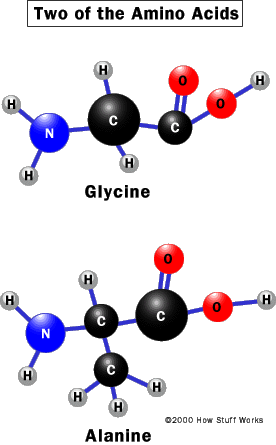Proteins
A protein is any chain of amino acids. An amino acid is a small molecule that acts as the building block of any protein. If you ignore the fat, your body is about 20-percent protein by weight. It is about 60-percent water. Most of the rest of your body is composed of minerals (for example, calcium in your bones).
Amino acids are called "amino acids" because they contain an amino group (NH2) and a carboxyl group (COOH) that is acidic. In the figure above, you can see the chemical structure of two of the amino acids. You can see that the top part of each one is the same. That is true of all amino acids -- the little chain at the bottom (the H or the CH3 in these two amino acids) is the only thing varying from one amino acid to the next. In some amino acids, the variable part can be quite large. The human body is constructed of 20 different amino acids (there are perhaps 100 different amino acids available in nature).
Advertisement
As far as your body is concerned there are two different types of amino acids: essential and non-essential. Non-essential amino acids are amino acids that your body can create out of other chemicals found in your body. Essential amino acids cannot be created, and therefore the only way to get them is through food. Here are the different amino acids:
Non-essential:
- Alanine (synthesized from pyruvic acid)
- Arginine (synthesized from glutamic acid)
- Asparagine (synthesized from aspartic acid)
- Aspartic acid (synthesized from oxaloacetic acid)
- Cysteine (synthesized from homocysteine, which comes from methionine)
- Glutamic acid (synthesized from oxoglutaric acid)
- Glutamine (synthesized from glutamic acid)
- Glycine (synthesized from serine and threonine)
- Proline (synthesized from glutamic acid)
- Serine (synthesized from glucose)
- Tryosine (synthesized from phenylalanine)
Essential:
- Histidine
- Isoleucine
- Leucine
- Lysine
- Methionine
- Phenylalanine
- Threonine
- Tryptophan
- Valine
Protein in our diets comes from both animal and vegetable sources. Most animal sources (meat, milk, eggs) provide what's called "complete protein", meaning that they contain all of the essential amino acids. Vegetable sources usually are low on or missing certain essential amino acids. For example, rice is low in isoleucine and lysine. However, different vegetable sources are deficient in different amino acids, and so by combining different foods you can get all of the essential amino acids throughout the course of the day. Some vegetable sources contain quite a bit of protein. Nuts, beans and soybeans are all high in protein. By combining them, you can get complete coverage of all essential amino acids.
The digestive system breaks all proteins down into their amino acids so that they can enter the bloodstream. Cells then use the amino acids as building blocks to build enzymes and structural proteins.
See How Food Works for additional information.
